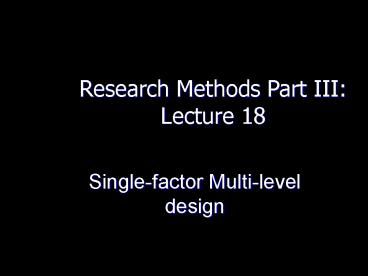Singlefactor Multilevel design - PowerPoint PPT Presentation
1 / 25
Title:
Singlefactor Multilevel design
Description:
One independent variable and more than two levels. Single ... Of course, the fellow could shout, but the human voice is not loud enough to carry that far. ... – PowerPoint PPT presentation
Number of Views:35
Avg rating:3.0/5.0
Title: Singlefactor Multilevel design
1
Single-factor Multi-level design
Research Methods Part III Lecture 18
2
Single-factor, Multilevel designs
- One independent variable and more than two levels
3
Aschs conformity study (1956)
4
Social Influence
- Aschs conformity experiments
5
Social Influence
6
Aschs conformity study (1956)
7
Single-factor, Multilevel designs - Examples
Darley Latané (1968) 1, 2, 5 conditions
(levels)
Epileptic Seizure
A
B
C
F
D
E
8
Darley Latané (1968)
9
Single-factor, Multilevel designs
- advantages
- be able to explore a trend including nonlinear
effects
10
Arousal and task performance
11
Single-factor, Multilevel designs
- advantages
- be able to explore a trend - nonlinear effects
- it can be used for testing specific alternative
hypotheses simultaneously - e.g., memory and context (Bransford Johnson,
1972) - how we comprehend new information? context
effect!
12
- If the balloons popped, the sound wouldnt be
able to carry, since everything would be too far
away from the correct floor. A closed window
would also prevent the sound from carrying, since
most buildings tend to be well insulated. Since
the whole operation depends on a steady flow of
electricity, a break in the middle of the wire
would also cause problem. Of course, the fellow
could shout, but the human voice is not loud
enough to carry that far. An additional problem
is that a string could break on the instrument.
Then there could be no accompaniment to the
message. It is clear that the best situation
would involve less distance. Then there would be
fewer potential problems. With face to face
contact, the least number of things could go
wrong.
13
(No Transcript)
14
Memory and Context (Bradford Johnson, 1972)
15
B
A
16
Memory and Context (Bradford Johnson, 1972)
17
Presenting data using graphs
- Types of variables
- continuous vs. discrete variable
- continuous variable
- its values are on a continuum
18
Line vs. Bar graphs
- Discrete variable - each value represent a
distinct category and no intermediate points
19
How to analyze the data?
- Analysis of variance (ANOVA)
- one-way ANOVA
- Simultaneously compare the mean differences among
more than two groups - basic idea
20
ANOVA
Total variance
Total variance
B
B
W
W
F ratio is small
F ratio is big
21
Subsequent analyses
- Overall F test
- planned vs. post hoc (after the fact) analysis
22
Single-factor, Multilevel designs
- within-subjects designs
- repeated measure
- example a hypothetical longitudinal study
examining the effect of age on logical thinking - 7 individuals
- measured 3 times (age 30, 45, 60)
23
Logical reasoning test
24
Logical reasoning test
60
25
Within-Subjects Single-Factor Design
- Analysis of variance (ANOVA) for repeated
measures - basic idea































